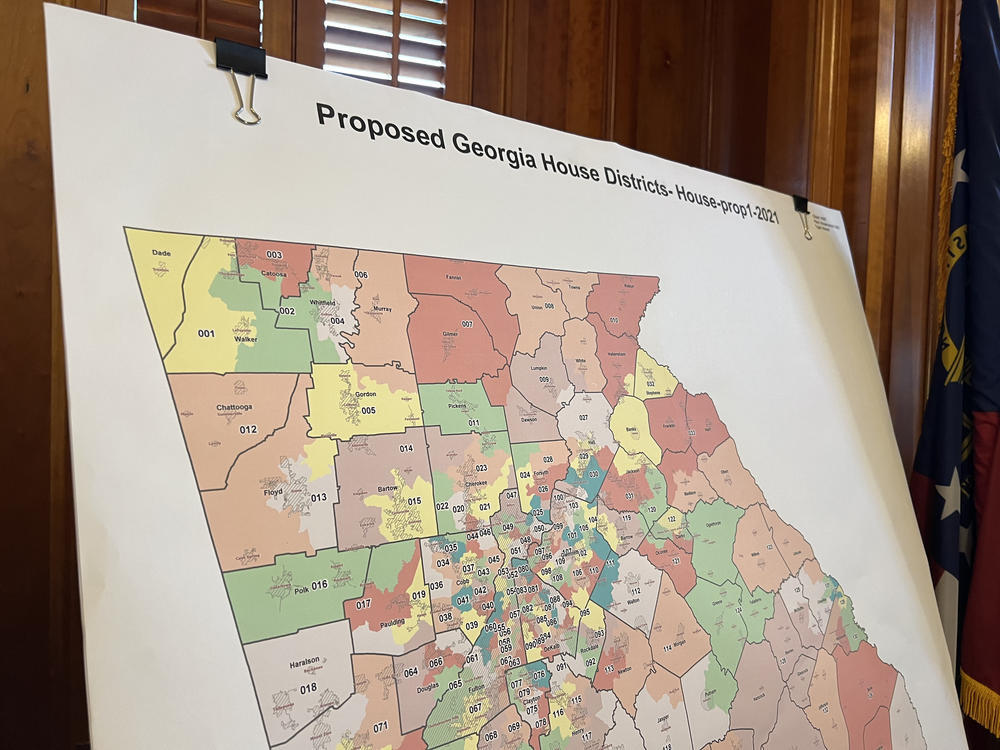Section Branding
Header Content
Georgia House, Senate approve their redistricting maps. What's next?
Primary Content
Georgia's state legislative maps are one step closer to reality after the House and Senate passed their redistricting plans this week. But the maps seem destined to be challenged in court, as Georgia continues to be a battleground state with national importance.
The 99-79 vote in the state House on Wednesday saw only two Republican "no" votes even as the new lines pair two sets of GOP incumbents against each other and one Republican with a Democratic incumbent in a liberal-leaning district.
Rep. Philip Singleton (R-Sharpsburg) was opposed to the proposal because it draws his district into south Fulton County, adding enough Democatic-leaning voters to likely remove him from office next year.
"If you allow your voice to be silenced, or you willingly submit your voice to a select few, you are complicit in the destruction of our republic," he said during a floor speech.
MORE: Here are all of the proposed redistricting maps for Georgia
House Speaker David Ralston (R-Blue Ridge) told reporters before the vote that Singleton's district had to change because of demographic shifts and the Voting Rights Act and that it was not "political payback" for Singleton's frequent clashing with Republican leadership.
The House map could add as many as seven seats to the Democratic delegation next year by collapsing districts of retiring lawmakers into neighboring areas, flipping Singleton's seat and if Rep. Winifred Dukes (D-Albany) defeats Rep. Gerald Greene (R-Cuthbert) in their newly combined district.
According to an analysis of legislator home addresses found on personal financial disclosures and property tax records, two sets of incumbent Democrats planning to run for reelection would likely be paired together: Rebecca Mitchell and Shelly Hutchinson in Snellville and Rep. Carl Gilliard (D-Garden City) with Rep. Derek Mallow (D-Savannah).
While Republicans defended their work and the legality of their boundaries, Democrats laid the groundwork for likely lawsuits over the maps in floor speeches Wednesday.
"Legitimate yet differing communities of interest should not be disregarded in the interest of race," Rep. Mary Margaret Oliver (D-Decatur) said. "The practical consequences of drawing a district to cover two distant, disparate communities is that one or more — or both — groups will likely be unable to achieve their political goals."
The Democrats' proposed map would have virtually similar partisan breakdowns as the map Republicans advanced, but make changes in different areas, targeting more vulnerable metro Atlanta Republicans and creating a new Clayton County-based seat.
In the Senate, the party-line 34-21 vote sets up a slightly different debate over the map's districts. Republicans created two new Democratic districts in metro Atlanta — one in Gwinnett and one in Fulton — by collapsing the districts of Sen. Bruce Thompson (R-White), who is running for Labor Commissioner, and Sen. Tyler Harper (R-Ocilla), who is running for Agriculture Commissioner.
The map also gives Democratic Sen. Michelle Au (D-Johns Creek) a tougher road to reelection by adding in conservative-leaning Forsyth and Gwinnett County precincts to her district.

"Georgia grew by 1 million people in the last decade, and 100% of that growth came from communities of color," Sen. Elena Parent (D-Atlanta) said. "So we would expect to see maps that more properly and appropriately reflect the increase in the population of communities of color."
Au, who is Asian American, would go from representing a majority non-white district to one that is majority white.
The GOP map did include several district recommendations made in the Democrats' map, almost exactly copying the proposed lines for seats in Columbus and Southwest Georgia. But another sticking point was the new boundary line for Sen. Brian Strickland (R-McDonough), who continues to represent a large portion of majority-Black, majority-Democratic Henry County.
Democrats proposed Strickland's District 17 include only Henry County, which would be overwhelmingly Democratic and majority-Black.
"Why does the proposed 17th (District) have more than 24,000 fewer Black residents?," Sen. Emanuel Jones (D-Stockbridge) asked during the floor debate.
The maps must still pass through the opposite chamber before heading to the governor's desk, and lawmakers must still work on realigning the state's 14 congressional maps. But as soon as the governor's ink dries on the bills signing them into law, expect lawsuits to be filed.
The 2020 Census and redistricting cycle is the first where Georgia and some other jurisdictions no longer have to get maps pre-cleared by the federal government because of a history of racist voting changes, and several redistricting groups have already testified their concerns about the process and maps that will likely fill legal challenges.
But Republicans would like to remind that 20 years ago, when Democrats were in charge, they egregiously gerrymandered districts that were ultimately struck down in court. When asked if hammering the minority party for districts from several cycles ago would continue into the next decade, Ralston said "absolutely."
"Those were atrocious maps," Ralston said. "I think their last map is perfectly relevant."

